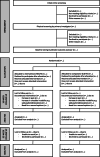A randomised controlled trial of heavy shoulder strengthening exercise in patients with hypermobility spectrum disorder or hypermobile Ehlers-Danlos syndrome and long-lasting shoulder complaints: study protocol for the Shoulder-MOBILEX study
- PMID: 33261635
- PMCID: PMC7705859
- DOI: 10.1186/s13063-020-04892-0
A randomised controlled trial of heavy shoulder strengthening exercise in patients with hypermobility spectrum disorder or hypermobile Ehlers-Danlos syndrome and long-lasting shoulder complaints: study protocol for the Shoulder-MOBILEX study
Abstract
Background: Four out of five patients with hypermobility spectrum disorder (HSD) or hypermobile Ehlers-Danlos syndrome (hEDS) experience shoulder complaints including persistent pain and instability. Evidence suggests that patients with HSD/hEDS who experience knee and back complaints improve with exercise-based therapy. However, no study has focused on exercise-based treatment for the shoulder in this patient group. The potential benefits of strengthening the shoulder muscles, such as increased muscle-tendon stiffness, may be effective for patients with HSD/hEDS who often display decreased strength and increased shoulder laxity/instability. The primary aim is to investigate the short-term effectiveness of a 16-week progressive heavy shoulder strengthening programme and general advice (HEAVY) compared with low-load training and general advice (LIGHT), on self-reported shoulder symptoms, function, and quality of life.
Methods: A superiority, parallel group, randomised controlled trial will be conducted with 100 patients from primary care with HSD/hEDS and shoulder complaints (persistent pain and/or instability) for more than 3 months. Participants will be randomised to receive HEAVY (full range of motion, high load) or LIGHT (neutral to midrange of motion, low load) strengthening programme three times weekly with exercises targeting scapular and rotator cuff muscles. HEAVY will be supervised twice weekly, and LIGHT three times during the 16 weeks. The primary outcome will be between-group difference in change from baseline to 16-week follow-up in the Western Ontario Shoulder Instability Index (WOSI, 0-2100 better to worse). Secondary outcomes will include a range of self-reported outcomes covering symptoms, function, and quality of life, besides clinical tests for shoulder strength, laxity/instability, and proprioception. Outcome assessors will be blinded to group allocation. Participants will be kept blind to treatment allocation through minimal information about the intervention content and hypotheses. Primary analyses will be performed by a blinded epidemiologist.
Discussion: If effective, the current heavy shoulder strengthening programme will challenge the general understanding of prescribing low-load exercise interventions for patients with HSD/hEDS and provide a new treatment strategy. The study will address an important and severe condition using transparent, detailed, and high-quality methods to potentially support a future implementation.
Trial registration: ClinicalTrials.gov NCT03869307 . Registered on 11 March 2019.
Keywords: Hypermobile Ehlers-Danlos syndrome; Hypermobility; Hypermobility spectrum disorder; Shoulder; Strength; WOSI.
Figures
Similar articles
-
Short-term effectiveness of high-load compared with low-load strengthening exercise on self-reported function in patients with hypermobile shoulders: a randomised controlled trial.Br J Sports Med. 2022 Jun 1;56(22):1269-76. doi: 10.1136/bjsports-2021-105223. Online ahead of print. Br J Sports Med. 2022. PMID: 35649707 Free PMC article.
-
One-year effectiveness of high-load compared with low-load strengthening exercise on self-reported function in patients with hypermobile shoulders: a secondary analysis from a randomised controlled trial.Br J Sports Med. 2024 Mar 21;58(7):373-381. doi: 10.1136/bjsports-2023-107563. Br J Sports Med. 2024. PMID: 38253436 Free PMC article. Clinical Trial.
-
Heavy shoulder strengthening exercise in people with hypermobility spectrum disorder (HSD) and long-lasting shoulder symptoms: a feasibility study.Pilot Feasibility Stud. 2020 Jul 10;6:97. doi: 10.1186/s40814-020-00632-y. eCollection 2020. Pilot Feasibility Stud. 2020. PMID: 32670599 Free PMC article.
-
Physical and mechanical therapies for lower limb symptoms in children with Hypermobility Spectrum Disorder and Hypermobile Ehlers-Danlos Syndrome: a systematic review.J Foot Ankle Res. 2018 Nov 7;11:59. doi: 10.1186/s13047-018-0302-1. eCollection 2018. J Foot Ankle Res. 2018. PMID: 30455744 Free PMC article.
-
Physical therapy interventions in generalized hypermobility spectrum disorder and hypermobile Ehlers-Danlos syndrome: a scoping review.Disabil Rehabil. 2024 May;46(10):1936-1953. doi: 10.1080/09638288.2023.2216028. Epub 2023 May 25. Disabil Rehabil. 2024. PMID: 37231592
Cited by
-
Fascial Pathophysiology in Hypermobility Spectrum Disorders and Hypermobile Ehlers-Danlos Syndrome: A Review of Emerging Evidence.Int J Mol Sci. 2025 Jun 11;26(12):5587. doi: 10.3390/ijms26125587. Int J Mol Sci. 2025. PMID: 40565051 Free PMC article. Review.
-
Short-term effectiveness of high-load compared with low-load strengthening exercise on self-reported function in patients with hypermobile shoulders: a randomised controlled trial.Br J Sports Med. 2022 Jun 1;56(22):1269-76. doi: 10.1136/bjsports-2021-105223. Online ahead of print. Br J Sports Med. 2022. PMID: 35649707 Free PMC article.
-
One-year effectiveness of high-load compared with low-load strengthening exercise on self-reported function in patients with hypermobile shoulders: a secondary analysis from a randomised controlled trial.Br J Sports Med. 2024 Mar 21;58(7):373-381. doi: 10.1136/bjsports-2023-107563. Br J Sports Med. 2024. PMID: 38253436 Free PMC article. Clinical Trial.
References
-
- Remvig L, Jensen DV, Ward RC. Epidemiology of general joint hypermobility and basis for the proposed criteria for benign joint hypermobility syndrome: review of the literature. J Rheumatol. 2007;34(4):804–809. - PubMed
-
- Juul-Kristensen B, Ostengaard L, Hansen S, Boyle E, Junge T, Hestbaek L. Generalised joint hypermobility and shoulder joint hypermobility, - risk of upper body musculoskeletal symptoms and reduced quality of life in the general population. BMC Musculoskelet Disord. 2017;18(1):226. doi: 10.1186/s12891-017-1595-0. - DOI - PMC - PubMed
-
- Mulvey MR, Macfarlane GJ, Beasley M, Symmons DP, Lovell K, Keeley P, Woby S, McBeth J. Modest association of joint hypermobility with disabling and limiting musculoskeletal pain: results from a large-scale general population-based survey. Arthritis Care Res (Hoboken) 2013;65(8):1325–1333. doi: 10.1002/acr.21979. - DOI - PubMed
Publication types
MeSH terms
Associated data
Grants and funding
LinkOut - more resources
Full Text Sources
Medical



